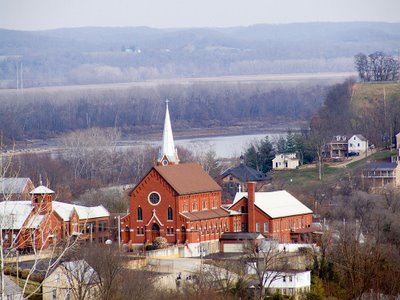
Saint George's church, with the Missouri River in the background.
In the 1820s, Gottfried Duden of Germany wrote a bestselling book about his travels in the western United States, concentrating on the lower Missouri River valley—which reminded him of the Rhine River valley—and strongly encouraged his countrymen to move to America to escape political and economic turmoil. The German Settlement Society of Philadelphia purchased more than 11,000 acres in this area, and planned an almost-Utopian community that would preserve their language and way of life, in freedom.
Like the Rhine River valley in Germany, the first settlers discovered that this area is excellent for growing grapes, and even has some native grape varieties that are suitable for making wine. By the late 19th century, Hermann was the center of a very large wine industry, which has been reestablished since the 1960s. Many vineyards and wineries are located here, making Hermann a tourist destination.
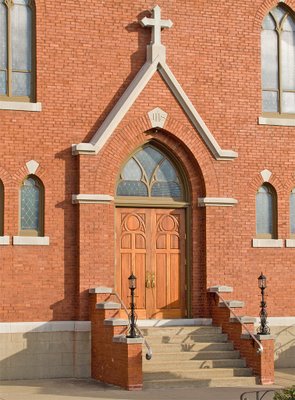
Front door.
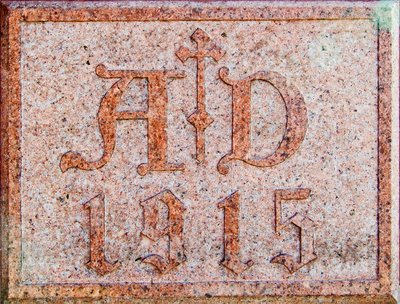
Cornerstone. A.D. 1915
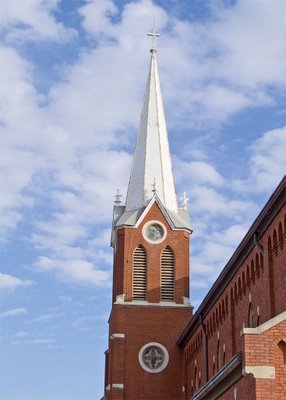
The steeple dates from 1900 and comes from an earlier church building on this site.
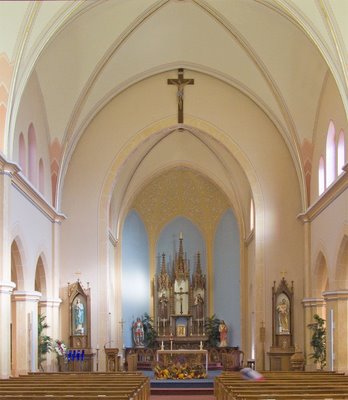
Nave of the church.
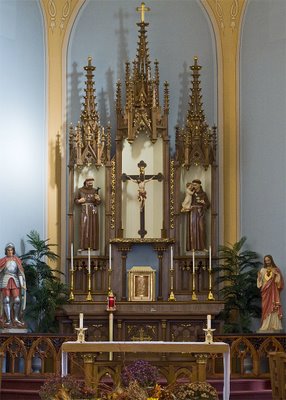
The sanctuary. For many years, the parish was staffed by Franciscan Friars of the Sacred Heart Province, from Saint Louis. These are statues of Franciscan Saints over the altar. The altars here were carved by two of the friars.
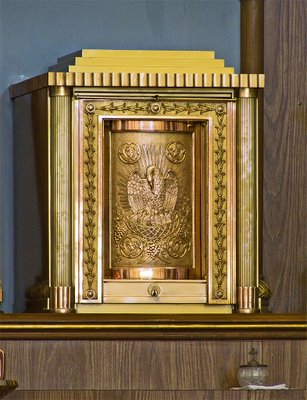
Tabernacle, with the pelican symbol, and the symbols of the Evangelists.

Statue of Saint George. He was a Roman soldier in the personal guard of the Emperor Diocletian. He was martyred in A.D. 303 because of his refusal to participate in a persecution of Christians.

Processional crucifix.

Baptismal font is to the right of the altar.
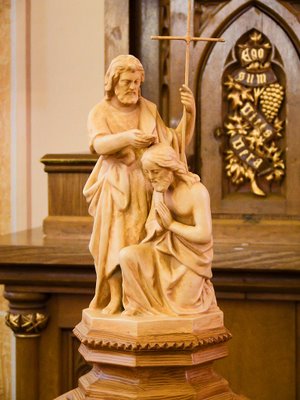
Detail on font depicts the baptism of Christ by John the Baptist.
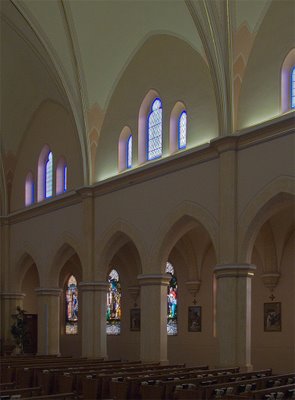
View of nave to the side.
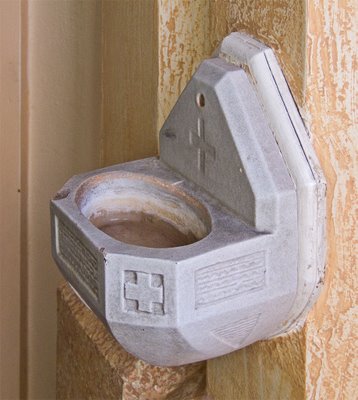
Holy water font carved out of stone.
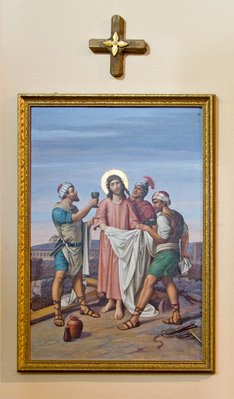
Station of the Cross; Jesus is stripped of his garments.
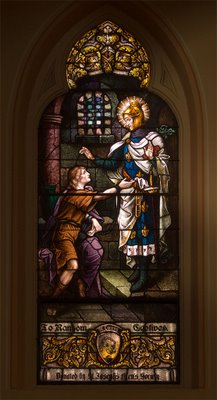
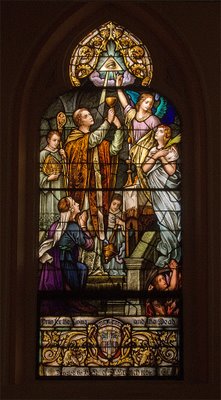

In most churches, the stained glass windows depict either scenes from scripture or images of Saints, but these show the corporal (bodily) and spiritual works of mercy. The corporal works are: to feed the hungry; to give drink to the thirsty; to clothe the naked; to shelter the homeless; to visit the sick; to ransom the captive; and to bury the dead. The spiritual works are: to instruct the ignorant; to counsel the doubtful; to admonish sinners; to bear wrongs patiently; to forgive offenses willingly; to comfort the afflicted; and to pray for the living and the dead. The Church proposes that these are not just commands for Christians, but are self-evident from the natural law.
The windows date from 1924, and ten of them come from Germany.

St. George's School, dating from 1870. Until recently, it was staffed by various religious orders.
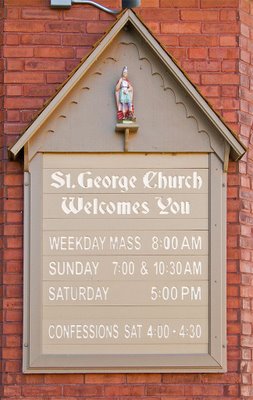
Mass Times.
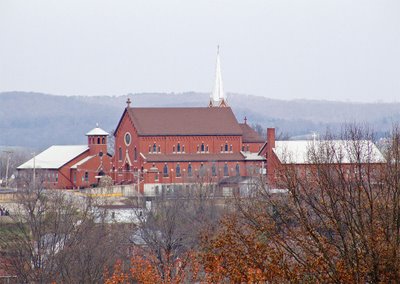
Another view of the church, as seen from Stone Hill Winery, once the nation's second-largest maker of wine.
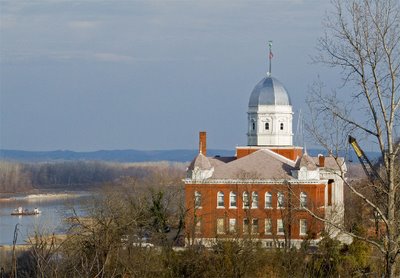
Near the church is the county courthouse, completed in 1898, and sited atop a bluff overlooking the Missouri River. If you look closely, you can see a video camera atop the dome; this monitored progress on the construction of the new bridge over the river: you can see the archived pictures here.
Hermann is the county seat of Gasconade County, which got its name because its French colonial inhabitants had the same boastful character as natives of Gascony in France.
Hermann is named after the German military leader Arminius (re-christened Hermann by Martin Luther), who wiped out three legions of the Roman army at the Battle of the Teutoburg Forest in A.D. 9. Caesar Augustus "was so greatly affected that for several months in succession he cut neither his beard nor his hair, and sometimes he could dash his head against a door, crying "Quintilius Varus, give me back my legions!" (Suetonius). Because of his defeat of Rome, Hermann became a hero of the German nationalistic, Protestant, and National Socialist causes. Although after Rome's defeat the Rhine remained the border of the Empire, Hermann and his army were later destroyed by eight Roman legions.
The first immigrants to Hermann tended to be Freethinkers or Liberal religionists, but 33 Catholics were among the first settlers, and they got their own pastor in 1849. At the time of its founding, the parish was in the Archdiocese of Saint Louis, and in 1956 became a part of the newly-erected Diocese of Jefferson City.
Hermann is about seven miles from the Shrine of Our Lady of Sorrows, in Starkenburg, Missouri.
Click here for a history of churches in Hermann.
Diocesan web site:
http://parishesonline.net/scripts/HostedSites/Org.asp?ID=11662
Address:
128 West 4th Street
Hermann, Missouri 65041


No comments:
Post a Comment